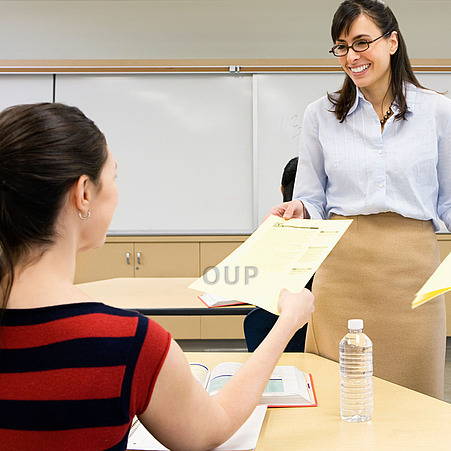 How can you create your own material? What do you need? What would you include? How long would it take? Charl Norloff, co-author of Q: Skills for Success Reading/Writing 4, looks at how to supplement a textbook with your own materials.
How can you create your own material? What do you need? What would you include? How long would it take? Charl Norloff, co-author of Q: Skills for Success Reading/Writing 4, looks at how to supplement a textbook with your own materials.
Published materials are useful tools for busy teachers as they provide appropriately-leveled lessons and activities carefully crafted to provide optimum practice for students. However, most teachers feel the need to create their own materials for their classes at some time. This is something that you can do with time and some practice, and it doesn’t have to be time-consuming or require a lot of supplies. Whether you make copies of your teacher-made materials for students, use technology to project them, or even simply write them on the board, depends on your situation, but here are some tips to consider when creating your own materials:
Start by asking yourself what the purpose of the activity will be
What is the objective of the lesson and which skills are you teaching? Try to write a student learning outcome, i.e., what do you want your students to be able to do after using the materials? The clearer you are about what you want the outcome to be, the better your chances of creating effective materials for your students.
Keep it simple
Don’t make the exercise or activity too complicated and keep the directions brief and clear. Consider how much time you will spend on the activity for which you are developing the materials. If it takes too much time to set up or is too difficult, it may not be worth the time spent. Ask yourself how to get the maximum engagement from your students and the most practice in the simplest and most time-efficient way.
Personalize your content
The biggest advantage of, and a reason for, creating your own materials is that you can use the context of your students and their personal lives and stories to make the materials memorable and meaningful to your students, so make your materials about your students and your community as much as possible.
Invest more time and thought into content than appearance
Your materials don’t have to look professional. Strive for materials that help the students use the language to communicate with each other.
Try the materials out yourself
Once you’ve created your materials, try them yourself to make sure they are doing what you want them to. If students are reading something, can they answer the questions without reading? If students are supposed to write using a particular grammar structure, does the prompt require the use of the structure? If the materials don’t work for you, they won’t work for your students.
Try the materials with your students
Finally, use your materials with your students. They probably won’t be perfect, but that’s OK. Make notes on what worked and what didn’t so you can adapt them if necessary for the next time. The more you create materials to fit your class and your students, the better you will become at it.
Teacher-created materials can be a great way to supplement your textbooks. Have you created materials to use in class? How successful were they?


Reblogged this on lessonsinefl.
[…] Bringing teachers and other ELT professionals top quality resources, tools, hints and tips, news, ideas, insights and discussions to help further their ELT career. Follow Oxford ELT on Twitter. Find Oxford ELT on Google+. […]
[…] How can you create your own material? What do you need? What would you include? How long would it take? Charl Norloff, co-author of Q: Skills for Success Reading/Writing 4, looks at how to suppleme… […]
[…] How can you create your own material? What do you need? What would you include? How long would it take? Charl Norloff, co-author of Q: Skills for Success Reading/Writing 4, looks at how to supplement a textbook with your own materials. […]
[…] you decide to create your own materials for your lesson, here are a few tips from the Oxford University Press blog. Adam Simpson talks about 6 things that […]